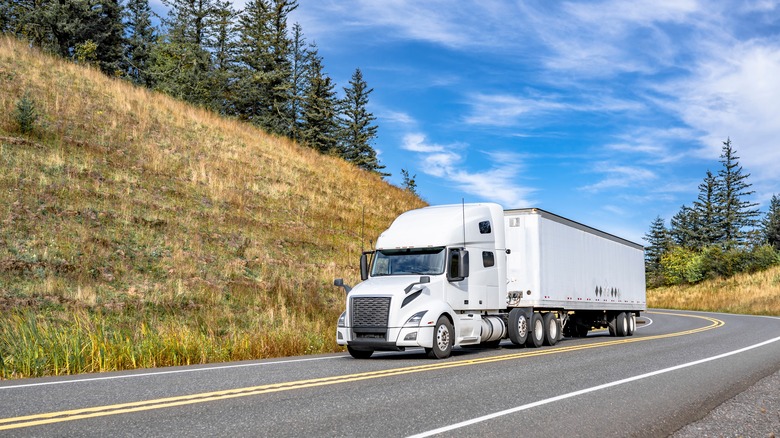What Are Jake Brakes And How Are They Different From Regular Brakes?
Semi-trucks are an integral component to a healthy supply chain, transporting goods across the country daily. In fact, there's millions of semi-trucks on US roads each day. Over the years, advances have been made to help big rigs perform more efficiently and safely on America's roads.
The Jacobs Engine Brake or Jake Brake for short, alters a semi-truck's valve timing so that the engine helps slow it down and reduces the forces placed on the truck's standard brakes. A modern semi-truck diesel engine is typically a four-stroke, which includes four phases to generate energy: the intake, compression, expansion, and exhaust strokes. When a Jake Brake is activated, the exhaust valve opens at the compression phase, instead of remaining closed to allow pressure to build and expand. This releases the energy into the exhaust system, and absorbs it, effectively helping to slow the truck down.
In terms of standard braking systems, many heavy trucks use air brakes. The wheel hub assembly of a semi includes components like a brake drum, and connection to the axel. Within the brake drum, there are two half-moon shaped pieces called shoes, that include an outer lining. In order to stop, compressed air activates an s-cam, that then forces the shoes against the drum causing friction.
Why would a truck need to use a Jake Brake?
When loaded full with cargo (laden weight), a big rig plus trailer, could legally tip the scales at up to 80,000 pounds. Now imagine all that weight picking up momentum on a steep downgrade, when the driver attempts to slow down, all that energy gets focused on the trucks braking system. Frighteningly, the more a driver attempts to slow down, the more heat is created, causing something called "brake fade," which renders the truck's ability to stop less and less effective.
Certain areas of the country, such I-70 through the Colorado Rockies, feature mountain passes between 6 and 8% grades, that can stretch as far as 10 miles. With nothing but standard air brakes, eventually the driver wouldn't be able to control the trucks speed. It's at this point a driver frantically searches the road ahead for a runaway truck ramp.
A familiar name invented the Jacobs Engine Brake
Clessie Cummins, the man behind famed Cummins engines was the one who actually created the Jake Brake following a harrowing incident. In 1931, Cummins was behind the wheel of a truck during a long-haul journey spanning America's coasts. He suddenly suffered brake fade as he attempted to slowdown on the backend of a mountain pass in California. This situation nearly ended in tragedy as Cummins came close to a collision with a train. The incident not only shook Cummins, but it provided the creative fuel to develop the Jacobs Engine Brake, to help prevent similar scenarios. Do you know what the difference between a Jake Brake and Retarder is in semi-trucks?
Interestingly, the Cummins company didn't want to develop Clessie's idea, and so, he made an agreement with the Jacob's Manufacturing Co. Ironically, Cummins would start installing Jake Brakes in its engines starting in 1961 and still does to this day. Although, in 2022, Cummins gained control over Jacobs Vehicle Systems (manufacturer of the Jake Brake), bringing the founder's original idea back under the Cummins umbrella.


